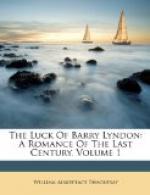To come from the story as a whole to the personality of the eponymous hero. Three widely-differing historical individuals are suggested as having contributed to the composite portrait. Best known of these was that very prince among adventurers, G. J. Casanova de Seingalt, a man who in the latter half of the eighteenth century played the part of adventurer—and generally that of the successful adventurer—in most of the European capitals; who within the first five-and-twenty years of his life had been ’abbe, secretary to Cardinal Aquaviva, ensign, and violinist, at Rome, Constantinople, Corfu, and his own birthplace (Venice), where he cured a senator of apoplexy.’ His autobiography, Memoires ECRIT par lui meme (in twelve volumes), has been described as ’unmatched as a self-revelation of scoundrelism.’ It has also been suggested, with I think far less colour of probability, that the original of Barry was the diplomatist and satiric poet Sir Charles Hanbury Williams, whom Dr Johnson described as ’our lively and elegant though too licentious lyrick bard.’ The third original, and one who, there cannot be the slightest doubt, contributed features to the great portrait, is a certain Andrew Robinson Stoney, afterwards Stoney-Bowes.
The original of the Countess Lyndon was Mary Eleanor Bowes, Dowager Countess of Strathmore, and heiress of a very wealthy Durham family. This lady had many suitors, but in 1777 Stoney, a bankrupt lieutenant on half pay, who had fought a duel on her behalf, induced her to marry him, and subsequently hyphenated her name with his own. He became member of Parliament, and ran such extravagant courses as does Barry Lyndon, treated his wife with similar barbarity, abducted her when she had escaped from him, and then, after being divorced, found his way to a debtors’ prison. There are similarities here which no seeker after originals can overlook. Mrs Ritchie says that her father had a friend at Paris, ’a Mr Bowes, who may have first told him this history of which the details are almost incredible, as quoted from the papers of the time.’ The name of Thackeray’s friend is a curious coincidence, unless, as may well have been the case, he was a connection of the family into which the notorious adventurer had married. It is not unlikely that Thackeray had seen the work published in 1810—the year of Stoney-Bowes’s death—in which the whole unhappy romance was set forth. This was ’the lives of Andrew Robinson Bowes Esq., and the countess of Strathmore. Written from thirty-three years’ Professional Attendance, from letters and other well authenticated Documents by Jesse Foot, Surgeon.’ In this book we find several incidents similar to ones in the story. Bowes cut down all the timber on his wife’s estate, but ’the neighbours would not buy it.’ Such practical jokes as Barry Lyndon played upon his son’s tutor were played by Bowes on his chaplain. The story of Stoney and his marriage will be found briefly given in the notice of the Countess’s life in the dictionary of national biography.




